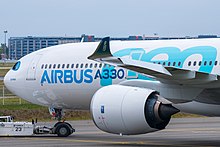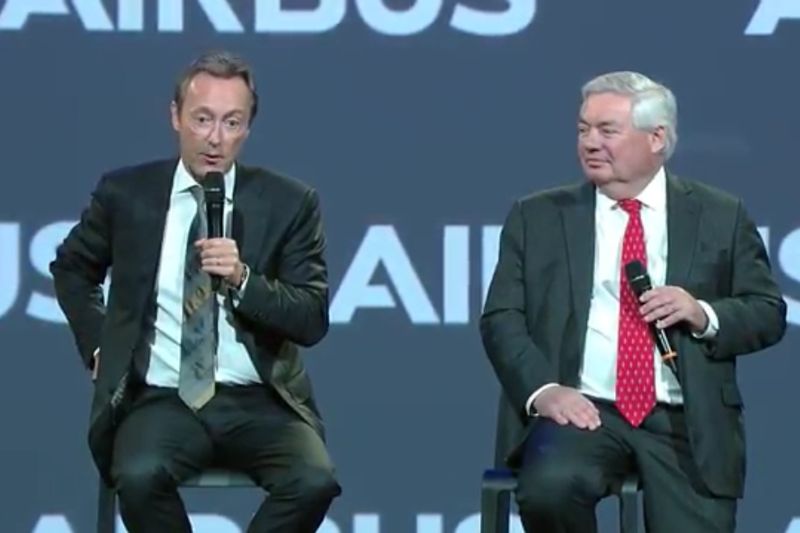Leeham News and Analysis
There's more to real news than a news release.
Déjà vu all over again
Subscription Required
Introduction
 April 16, 2018, © Leeham News: There’s high turnover in the executive ranks. Major delivery delays cause disruption and unhappy customers. Airlines are cancelling and switching orders. Product strategy is challenged. Your competitor is taking advantage and making significant inroads.
April 16, 2018, © Leeham News: There’s high turnover in the executive ranks. Major delivery delays cause disruption and unhappy customers. Airlines are cancelling and switching orders. Product strategy is challenged. Your competitor is taking advantage and making significant inroads.
If this sounds familiar, it is.
It’s déjà vu all over again.
Pontifications: Shooting yourself in your feet
April 16, 2018, © Leeham News: Airbus’ new top sales chief, Eric Schulz, was candid about losing American and Hawaiian airlines wide-body orders, according to a report from Flightglobal from the Airbus annual meeting.
In reference to Hawaiian’s switch of an A330-800 order to the 787-9, he admits: “Maybe we did not see the danger coming…we may have made the conclusion a bit too early that the best solution was to stick with us – which I think it was,” Flightglobal wrote.
American’s loss, Schulz told Flightglobal, was for a different reason: American was “already very heavily engaged” with the 787, adding: “I knew exactly where our competitors had to go in terms of pricing. I’m certain American did a good deal.”
I thought American and Hawaiian were predictable outcomes. But Airbus’ problem went beyond not seeing the “danger.”
American A330neo loss casts shadow over sales prospects
Subscription Required
Introduction
April 9, 2018, © Leeham News: Even as Airbus touted the new 251t A330-800 and optimism that aging A330-200s will kick start a replacement cycle in 2020-21, the

Airbus A330neo. Photo via Google images.
concurrent loss of a campaign to sell the model to American Airlines casts a shadow over the model and the entire program.
Airbus had just come off the cancellation of the only A330-800 order, by Hawaiian Airlines, which flipped to the Boeing 787-9. As the sole customer for six A330-800s, the cancellation was expected.
Airbus hoped that an American order, for 20 -800s, would prove to be the endorsement of the program that was needed to spur worldwide sales.
Boeing was just as adamant that, like Hawaiian, American order the 787. In this case, Boeing had the leg up: the 787 was already in AA’s fleet (37 of 42 previous orders were already delivered). American wanted to simplify its fleet, not add another type. And airline officials were skeptical of the -800 for the very reason Airbus was so in need of AA’s order.
Summary
- American’s order would have been the boost needed for the A330neo program.
- It would have been an endorsement of the A330-800.
- The 251t, 8,150nm version of the -800 makes a good, niche long-haul airplane.
Pontifications: An old pro thinks long-haul LCC model is about who loses the most money
March 26, 2018, © Leeham News: Long-haul, low-cost carriers are likely here to stay but the impact will be limited.
This is the conclusion of Robert L. Crandall, former CEO of American Airlines, who faced the USA’s first ultra-low-cost carrier and won.
Crandall, 82, retired from American in 1998, He faced the emerging low-cost carriers in the US, all based in large part on the Southwest Airlines

Robert Crandall. Photo via Google images.
business model.
Despite painful skirmishes and in some cases, all-out wars, Crandall navigated American through the turbulent skies, making American the largest US airline and seeing nearly all of the upstarts cease operations.
PeoplExpress was the USA’s first ultra-low-cost carrier. Founded in 1981, over-expansion and aggressive response by the US majors—led in large part by Crandall’s strategy—PE collapsed in 1987. It merged into Continental Airlines, bankrupt in all but name.
In new blow, Boeing defeats Airbus at American, sources say; AA says ‘no decision yet’

Boeing 787. Photo via Google images.
March 23, 2018, © Leeham News: In a new, albeit not unexpected, blow to Airbus, Boeing won a hotly contest competition at American Airlines between the A330neo and the 787, two sources say.
Bloomberg News reported Airbus lost the deal, earlier today.
LNC confirmed the decision with two sources. But Derek Kerr, EVP and CFO of American, told LNC no decision has been made, but an announcement could be coming by the first quarter earnings call if not before.
The competition originated with American’s long-publicized ambivalence over the legacy Airbus A350-900 order placed by US Airways long before the latter acquired American, a 787 customer of long-standing. With this deal, American will cancel the A350 order for 22 airplanes.
Airbus, Boeing square off with A330neo, 787 in advance of NMA launch
Subscription Required
Introduction
Feb. 8, 2018, Leeham Co.: Boeing hasn’t launched the New Midrange Aircraft (NMA, aka 797) and may not until next year.
But the maneuvering to capture, solidify or preempt moves is already well underway by Airbus and Boeing.
Reuters synopsized this during its reporting at this week’s Singapore Air Show.
This is only the tip of the iceberg.
Summary
- Boeing 787 production rate increase to 14/mo next year is, in part, a head-‘em-off-at-the-pass maneuver to prevent customers from buying the Airbus A330neo.
- The 787-8 could see a new lease on life as interim airplane.
- A330-800 has steep uphill slog.
- Airbus, Boeing face off 787, A330neo.
2018 an important year for wide-bodied airplanes
Subscription Required
Introduction
Feb. 5, 2018, © Leeham Co.: This will be an important year for wide-body sales in commercial aviation.
It would be overstating to say 2018 will be a pivotal year for wide-body airplanes, but there should be some important developments.
Summary
- Boeing may—or may not—launch the twin-aisle New Midrange Aircraft this year.
- Sales of the 777X remain stalled.
- Sales of the A330neo remain stalled.
- Airbus must decide whether to boost the production rate of the A350.
Pontifications: Twelve Years of Turbulence at American Airlines
Jan. 22, 2018, © Leeham Co.: American Airlines was the last of the big US legacy carriers to enter bankruptcy, in 2011.
Executives put up a valiant battle to avoid being dragged into Chapter 11, despite having two airplanes hijacked on 9/11. One was flown into the World Trade Center, the other into the Pentagon.
Only two months later, American lost a third airplane in an accident.
Delta, Northwest, US Airways and United airlines all filed for Chapter 11 after 9/11; there were several other airlines to do so. Not all survived.
American did, merging with US Airways as part of the former’s bankruptcy reorganization.
AA’s former general counsel, Gary Kennedy, teamed with the aviation reporter for the Dallas Morning News, Terry Maxon, to tell the story of Twelve Years of Turbulence, The Inside Story of American Airlines’ Battle for Survival.
The book is available now.
It’s time to unwind, get healthy, eat right and avoid jet lag, says Airbus’ Leahy
John Leahy has been with Airbus 33 years, holding his current position as COO-Customers for more than 20 of these. He retires this month. Jan. 15’s 2017 year-end Orders and Deliveries press conference will be his last. LNC interviewed Leahy about his tenure at Airbus. Parts 1, 2 and 3 appear here, here and here. Today is Part 4. LNC’s Scott Hamilton has known Leahy for nearly 30 of these 33 years.
Jan. 12, 2018, © Leeham Co.: “I want to unwind, get healthy, eat right and not be in a constant state of jet lag. At 44, 45, I didn’t mind it. Right now, the thought of

The end of an era. Airbus President Fabrice Bregier (L) and COO Customers John Leahy. Bregier leaves Airbus next month after more than two decades. Leahy retires this month after more than three decades. Photo via Google images.
doing trips to Australia, I’d be jet lagged for three days.”
These are John Leahy’s plans for the first year after he retires in a matter of days after 33 years at Airbus.
When he was younger—that age 45 he referenced above—he thought nothing of working in Toulouse, Airbus headquarters, on Monday, getting on a plane to fly to Southeast Asia and Australia and be back in Toulouse to put in a full day on Friday—working the clock to make the long, long round trip.
“It was sort of fun,” he recalls. “I did a lot.” But not now.


